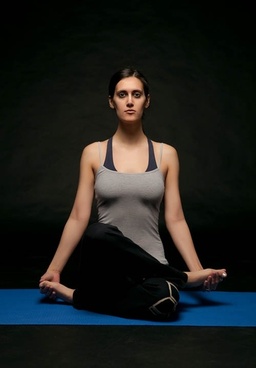APPLICATIONS OF YOGA THERAPY

The Chapter
V of the International Classification of Diseases focuses on mental disorders
and consists of ten main groups. Some remarks about the use of yoga are
included.
Organic
mental disorders.
Many
elderly people come to yoga classes. Mild physical activity is beneficial for
their mental health and cognitive functions including memory. The
contraindications and limitations are rather physical – e.g. staying long in
the asana with the neck bent backward is not advisable because it may impair
the blood supply to the brain.
Mental
and behavioural disorders due to use of psychoactive substances.
Avoid all
practices which may impair self-confidence of these people (i.e. too difficult
practices). Long meditation and even long yoga nidra may not be the best choice
in people who are disturbed or psychotic because of previous drug abuse.
Concurrent medical treatment should be recommended.
Schizophrenia,
schizotypal and delusional disorders.
Avoid long
meditation and long yoga nidra. Simple physical practices, emphasizing body
awareness and karma yoga are advisable. Antipsychotic drugs are not addictive
and they protect they the brain of people with schizophrenia.
Mood
(affective) disorders
The duration
of depressive mood should be at least two weeks to be classified as depression.
Any
physical sufficiently intensive exercise, such as Surya Namaskar, can alleviate
depression. Yoga can be very beneficial (Shapiro et al., 2007). Unfortunately
most depressive people do not like intensive exercises. Relaxation and simple
pranayama may be also useful to replenish their energy, if they can and want to
practice them.
Depressive
problems often last only for limited time period. Between these depressive periods
these people are more or less normal. They can practice and benefit from most
kinds of yoga. Concurrent medical treatment should be recommended in severely
depressive or suicidal people. Antidepressants are not addictive but their
effect is felt only after 2 – 4 weeks of regular use. That is why these drugs
are not useful in sad mood states lasting only for a short time.
Neurotic,
stress-related and somatoform disorders
Yoga,
including yoga nidra, can be helpful. Especially people with anxiety benefit
from yoga and like it. Benzodiazepines and some other anxiety and sleeplessness
relieving drugs are addictive and have side effects. Yoga represents often
better option here. The combination of yoga and psychotherapy is useful,
because yoga increases self-awareness and replenishes energy and thus enhances
progress in psychotherapy.
Behavioural
syndromes associated with physiological disturbances and physical factors
This group
includes eating disorders (anorexia nervosa, overeating, etc.), sleep
disorders, sexual dysfunction and abuse of non-dependence-producing substances
(e.g. purgatives). Yoga is usually beneficial. When dealing with sleep
disorders we teach shavasana and/or yoga nidra to be practiced at night. A
trainee should not finish the practice but remain in relaxed state after.
Disorders
of personality and behaviour in adult persons
Personality disorders: You can find here e.g. paranoid,
schizoid, dissocial or histrionic personality disorder. Personality disorders
are difficult to influence. A realistic aim is to help to these people to improve
self-control and learn useful social skills. Schizoid persons should not
practice long relaxation or meditation. Do not expect that somebody with
histrionic personality will practice yoga regularly and without an audience. Also do
not expect that the criminal with dissocial personality disorder will be
totally reformed after his first lesson of yoga.
Pathological gambling resembles addictions. Its treatment
is similar to the treatment of other addictive diseases. Yoga can help here to
increase self-awareness and to cope with stressful life situations.
Disorders of sexual preference such as exhibitionism, paedophilia
or sadomasochism may be accompanied by criminal activities. They should by
treated by a sexologist. Yoga can be used but not as the main tool.
Mental retardation. Yoga has been successfully applied here. The
instructions must be simple, clear and should be repeated. Yoga enhances the
social adaptation of these people.
Disorders of psychological development: You can find there e.g.
developmental disorders of speech and language, reading disorder, disorder of
arithmetical skills or childhood autism. There is not enough published
experience with the use yoga in these problems.
Behavioural
and emotional disorders with onset usually occurring in childhood and
adolescence
Hyperkinetic
disorder (or attention-deficit hyperactivity disorder) belongs to this group.
It is quite common. These children, even if intelligent, represent considerable
challenge both to parents and teachers. They should have enough physical
activity and their short attention span should be respected – it means e.g.
shorter periods of learning with more breaks. The use of yoga in this problems
is not an established treatment but is may be useful (Jensen and Kenny, 2004).
Yoga
teachers as outsiders and insiders
When I
practice yoga with my patients, I am an insider. The advantage is that it is
easier to organize the session and I know my trainees better. When I come to a
women’s department to practice yoga, I am an outsider. The advantage is that my
role as a teacher is not mixed with feelings related to the functioning of this
department. I feel more warmth there.
This
distinction would be even more apparent when teaching yoga in prisons or in the
army where hidden tensions and suppressed anger can be strong.











Post a Comment